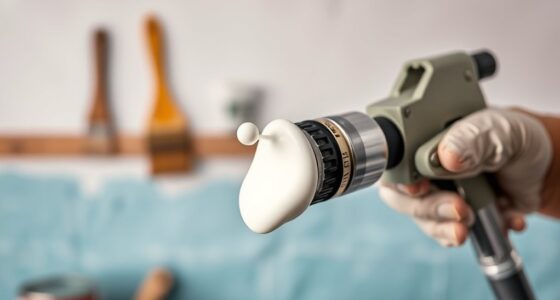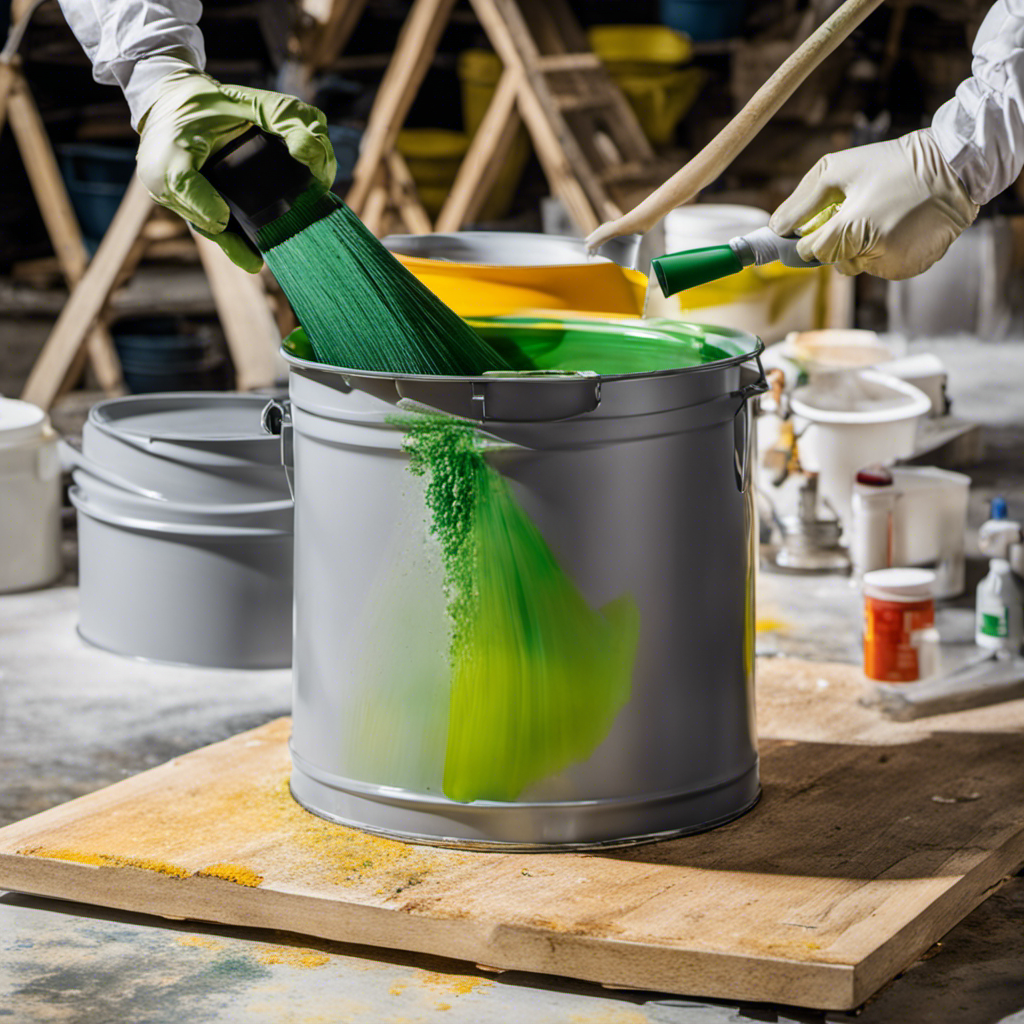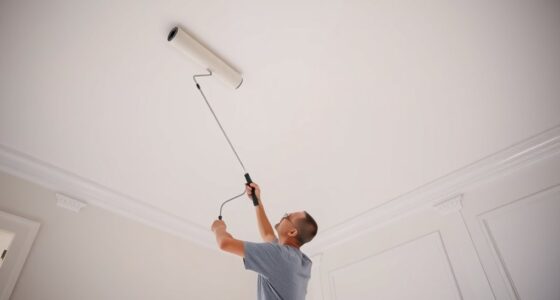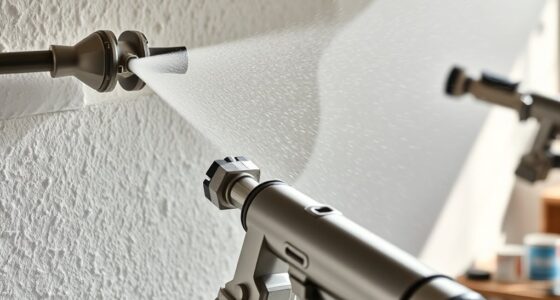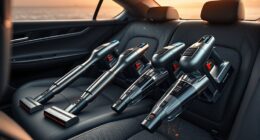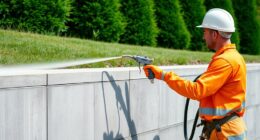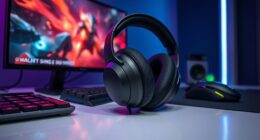Paint sprayers typically produce noise levels between 60 and 100 decibels, similar to a conversation or motorcycle. The loudness varies depending on the model, type, and operating conditions. HVLP sprayers tend to be quieter, while airless models are louder. Factors like pressure and equipment maintenance also influence noise levels. If you want to know how to minimize sound and protect your hearing, there’s more to discover below.
Key Takeaways
- Paint sprayers typically emit noise levels between 60-100 decibels, depending on the type and model.
- Airless sprayers tend to be louder (80-100 dB), while HVLP models are quieter (60-70 dB).
- Noise levels comparable to street traffic or vacuum cleaners can affect hearing protection needs.
- Proper maintenance and lower pressure settings can help reduce the noise produced by paint sprayers.
- Environmental factors and soundproofing techniques influence the perceived loudness of spray operations.
Typical Noise Levels of Different Paint Sprayers

Paint sprayers produce varying noise levels depending on their type and design. For example, airless sprayers from brands like Graco or Wagner tend to be louder, often reaching 80-100 decibels, while HVLP sprayers are quieter, around 60-70 decibels. Your choice of paint sprayer brand can impact noise, so researching quiet models helps. To keep noise levels manageable, follow maintenance tips such as cleaning filters regularly, lubricating moving parts, and checking for worn components. Proper maintenance not only prolongs your sprayer’s lifespan but also ensures it operates efficiently and quietly. Additionally, regular maintenance techniques can be a useful analogy, as they often involve specialized tools and techniques that can influence performance and noise levels. Remember, selecting the right brand and maintaining your equipment properly can considerably reduce noise, making your painting experience less disruptive and more comfortable.
How Noise Levels Are Measured in Decibels
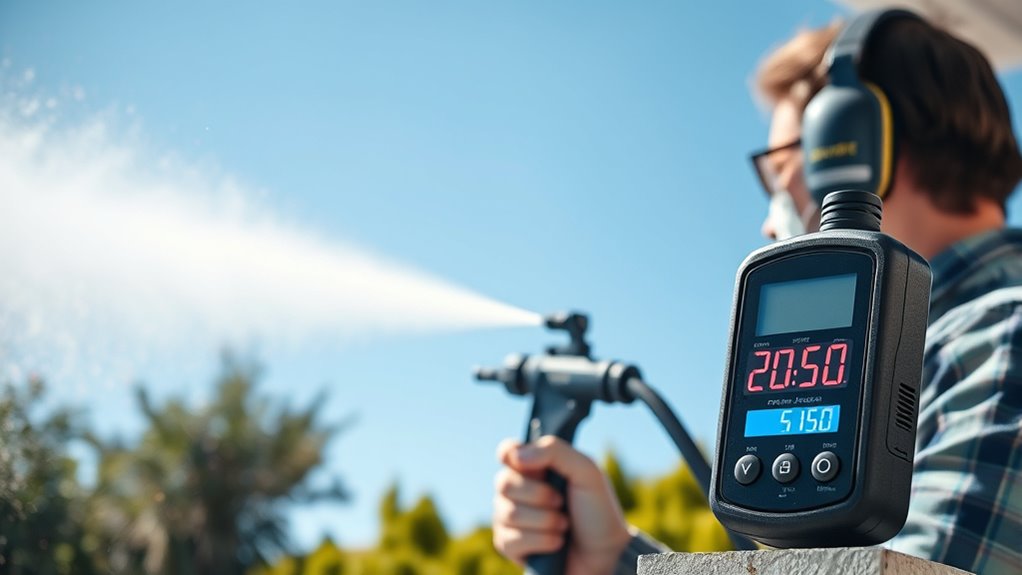
Noise levels are measured in decibels (dB), a unit that quantifies the intensity of sound. This decibel measurement helps you understand how loud a paint sprayer is by comparing it to familiar sounds. Sound intensity increases logarithmically, so small dB differences can seem significant. To visualize this, imagine the following:
| Sound Level | Example | Perception |
|---|---|---|
| 30 dB | Whisper | Quiet |
| 60 dB | Conversation | Moderate |
| 90 dB | Motorcycle | Loud |
| 120 dB | Jet engine | Very loud |
This table illustrates how decibel measurement translates into real-world sound perception, helping you gauge whether a paint sprayer’s noise level is safe or potentially harmful. Additionally, understanding industry trends can assist in selecting quieter equipment that meets safety standards. For example, modern paint sprayers are increasingly designed with noise reduction features, making them more suitable for enclosed spaces and reducing worker fatigue. As technology advances, the decibel levels of paint sprayers continue to decrease, improving safety and comfort during operation. Moreover, sound level regulations set limits to protect workers from hearing damage during prolonged exposure. Furthermore, awareness of noise exposure guidelines can help prevent hearing damage during prolonged use.
Comparing Paint Sprayer Noise to Everyday Sounds

Understanding the decibel levels of paint sprayers becomes more meaningful when you compare them to familiar sounds in your daily environment. For example, a typical paint sprayer noise ranges from 70 to 90 decibels, similar to street traffic or a loud vacuum cleaner. This sound level comparison helps you gauge how loud your sprayer might feel during operation. If you’re used to background noises like a conversation at 60 decibels, a paint sprayer will seem noticeably louder. On the other hand, it’s quieter than a motorcycle engine at 95 decibels. Recognizing these sound level comparisons makes it easier to protect your hearing and plan for appropriate ear protection during painting projects. Knowing where paint sprayer noise fits among everyday sounds provides valuable context. Additionally, choosing a high-quality airless sprayer with lower noise levels can contribute to a more comfortable working environment, allowing for longer work periods without discomfort or hearing damage. Being aware of sound wave influence can also help you understand how certain noise levels impact your overall well-being during prolonged exposure. For instance, prolonged exposure to noise levels above 85 decibels can lead to hearing loss, emphasizing the importance of protective measures. Moreover, selecting models with noise reduction features can significantly decrease the noise impact during use.
Factors That Influence the Loudness of a Paint Sprayer
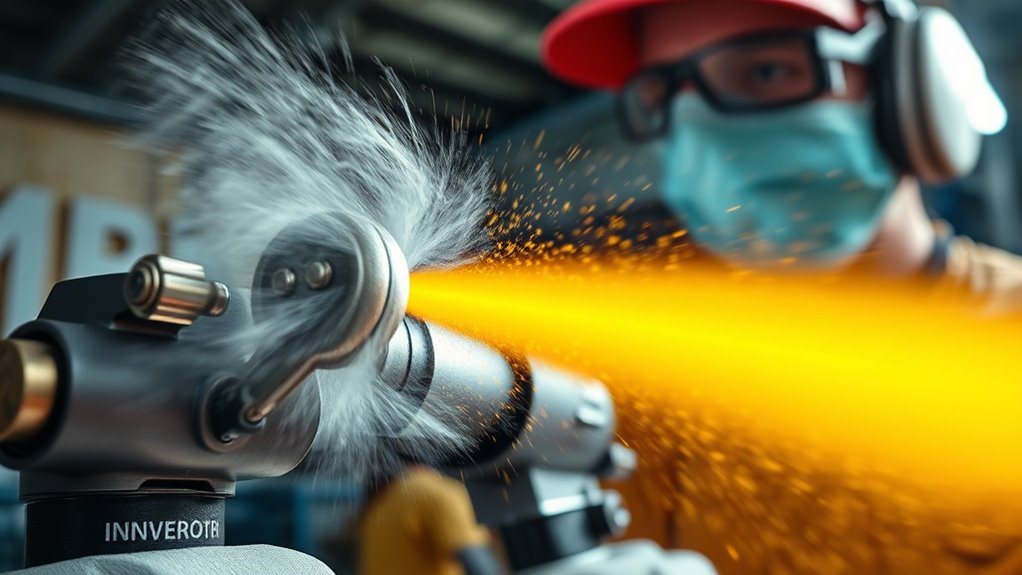
Several factors can markedly influence how loud a paint sprayer sounds during use. One major factor is the brand of the sprayer, as different paint sprayer brands incorporate varying engineering standards that affect noise output. Some brands focus on quieter operation by integrating noise reduction technology, which minimizes sound without sacrificing power. The type of sprayer also matters; HVLP models tend to be quieter than airless sprayers due to their design. Additionally, the pressure setting you choose impacts noise levels—higher pressure generally produces more sound. Finally, the condition of your equipment, like loose parts or worn components, can increase noise. Proper maintenance and sound design techniques can help reduce operational noise. For example, selecting a quiet operation model from a reputable brand can significantly diminish noise levels. Considering noise reduction features during your purchase can further help in minimizing the overall sound. Also, understanding the noise levels of various models before purchase can help you choose a quieter option. It is also beneficial to look into user reviews and specifications that highlight the noise output of specific models. By considering these factors, you can select a quieter model or optimize your setup for reduced noise during your painting projects.
Safety Guidelines for Noise Exposure While Using Paint Sprayers
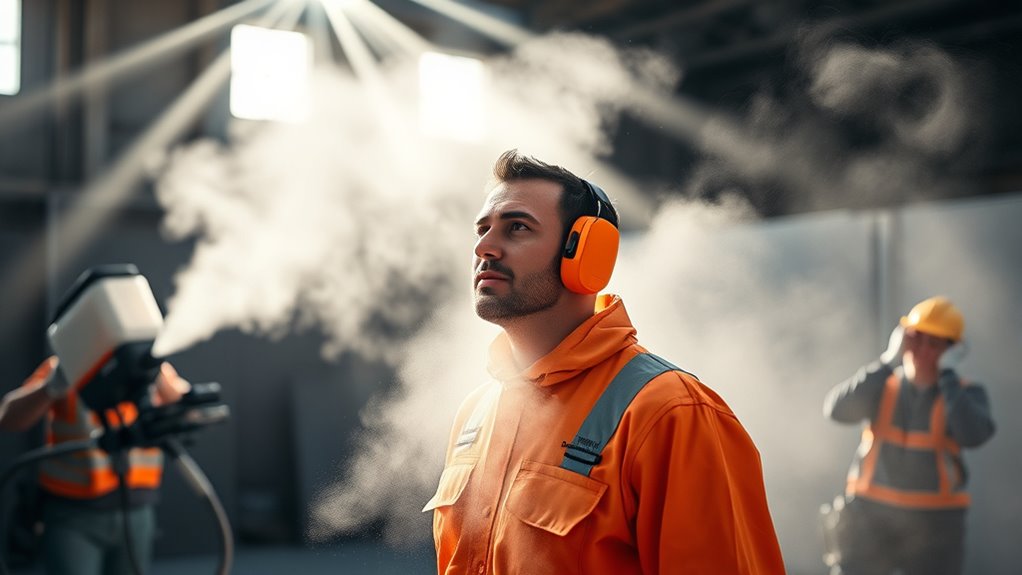
When using paint sprayers, protecting your hearing is essential to prevent damage from prolonged exposure to loud noise. Wear proper personal protective equipment, including earplugs or earmuffs, to shield your ears effectively. Conduct noise monitoring regularly to ensure sound levels stay within safe limits. Limit your exposure time, especially in noisy environments, and take breaks to reduce strain. The table below illustrates key safety measures:
| Safety Measure | Description | Purpose |
|---|---|---|
| Personal Protective Equipment | Use ear protection like earplugs or muffs | Prevent hearing damage |
| Noise Monitoring | Measure sound levels periodically | Maintain safe exposure levels |
| Exposure Duration | Limit continuous use of sprayers | Reduce risk of hearing loss |
| Breaks | Take regular breaks during spraying | Minimize noise exposure |
Following these guidelines helps keep your hearing safe during painting projects. Additionally, being aware of the noise levels produced by different sprayers can help you choose equipment that minimizes risk.
Tips for Reducing Noise and Protecting Your Hearing

To effectively reduce noise and protect your hearing while using paint sprayers, you should start by wearing high-quality ear protection, such as earplugs or earmuffs, every time you operate the equipment. Regular paint sprayer maintenance can minimize unnecessary noise caused by loose parts or clogged nozzles. Additionally, applying noise reduction techniques—like insulating your workspace or using sound-absorbing materials—can markedly lower noise levels. You can also understand how different filters work to ensure your equipment operates smoothly and quietly. Keep your sprayer well-maintained to prevent excessive noise, operate the sprayer at lower pressure settings when possible, and take frequent breaks to reduce overall noise exposure and give your ears a rest. Proper air purifier maintenance can also help ensure your workspace remains comfortable and free of airborne contaminants that may otherwise add to the noise environment. Being aware of the maintenance and tips for your equipment can further help in reducing noise levels and prolonging the lifespan of your tools. Regularly inspecting and replacing worn parts can significantly reduce operational noise and improve overall performance. Additionally, choosing quieter models or incorporating noise-reducing accessories can significantly contribute to a more comfortable and safer working environment. These steps will help you enjoy safer, quieter spraying sessions.
The Impact of Environment and Surroundings on Noise Perception
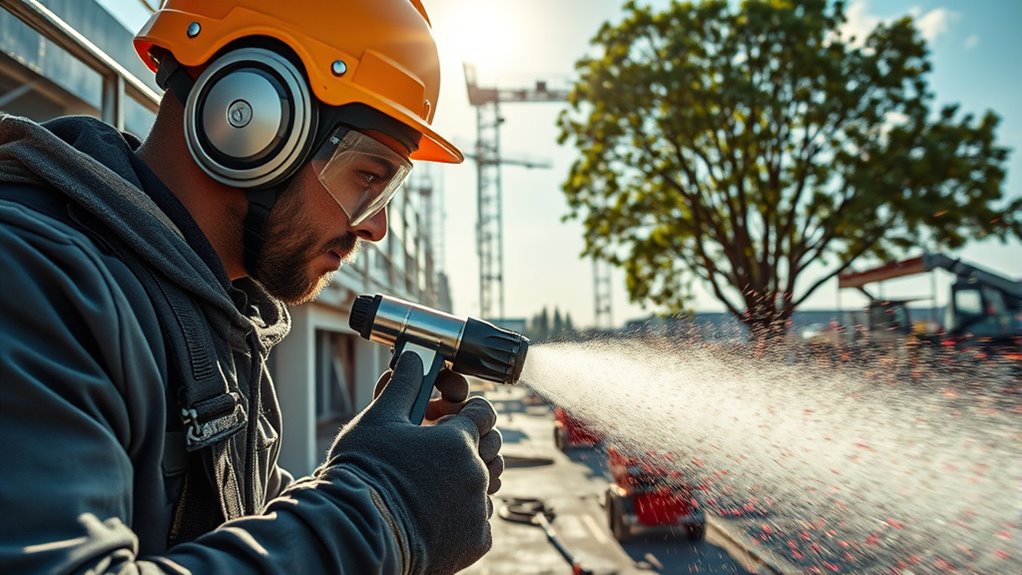
Your environment plays a big role in how you perceive paint sprayer noise. Ambient sounds can make it seem louder or quieter, depending on what’s happening around you. Reflection and absorption of sound in your surroundings can also change how intense the noise feels. Incorporating awareness of acoustics and soundproofing techniques can help manage perceived noise levels effectively. Additionally, understanding how home improvement methods influence sound can aid in creating a more comfortable workspace. Being aware of Pimple Patch technology can also inform strategies for reducing distractions caused by noise.
Ambient Noise Interference
Ambient noise from the environment and surroundings substantially influences how you perceive the noise levels of paint sprayers. External sounds can either mask or amplify the spray’s noise, making it seem louder or quieter than it actually is. For example, the presence of sound barriers can block or reduce ambient noise, improving your perception of quieter operation. Noise cancellation techniques, like wearing ear protection, also help you focus on the sprayer’s sound without interference. Additionally, outdoor environments with natural sounds may diminish perceived loudness compared to enclosed spaces, where echoes can intensify noise. Being aware of these factors helps you better evaluate actual noise levels and choose appropriate measures to minimize disturbance. Properly managing ambient noise guarantees a clearer understanding of your paint sprayer’s sound output.
Reflection and Absorption
The environment and surrounding surfaces play a crucial role in how you perceive the noise from a paint sprayer. Hard, reflective surfaces like concrete or metal cause sound waves to bounce, amplifying noise levels through reflection. In contrast, softer materials, such as foam or fabric, absorb sound, reducing overall noise. Implementing sound insulation and acoustic treatment can considerably improve comfort by minimizing reflections and controlling absorption. These measures prevent sound from echoing and spreading, making the space quieter. When setting up your workspace, consider adding acoustic panels or rugs to absorb sound and wall insulation to block noise transmission. By managing how sound reflects and absorbs in your environment, you can create a more pleasant, less chaotic noise experience while using your paint sprayer.
Regulations and Restrictions on Noise Levels for Power Tools

You need to be aware of the legal noise limits set by regulations to avoid penalties. Compliance requirements often specify maximum decibel levels for power tools like paint sprayers. Understanding these restrictions helps guarantee your equipment stays within safe and lawful noise boundaries.
Legal Noise Limits
Regulations and restrictions on noise levels for power tools are in place to protect workers and the public from excessive sound exposure. These limits help reduce noise pollution and prevent hearing damage. In many regions, legal standards specify maximum permissible noise levels, often measured in decibels (dB). For example, handheld tools may be limited to around 85 dB to minimize hearing protection needs. Authorities enforce these rules through permits and inspections, ensuring safety.
- Limits vary by country and industry, reflecting local health guidelines
- Noise pollution regulations aim to balance productivity with health safety
- Hearing protection is often required when working with noisy equipment, regardless of compliance
Compliance Requirements
Compliance requirements for noise levels in power tools set clear limits that manufacturers and users must guarantee to guarantee safety and legality. To meet these standards, proper paint sprayer maintenance is essential; poorly maintained equipment can exceed noise limits. You should regularly inspect and service your sprayer to keep it operating efficiently and within legal noise thresholds. Implementing noise reduction techniques, such as using quieter attachments or adding sound barriers, helps stay compliant. Regulations often specify maximum decibel levels for different settings, so understanding and adhering to these limits is crucial. Failing to comply can lead to fines or equipment restrictions. By prioritizing proper maintenance and noise control methods, you guarantee your paint sprayer operates safely, legally, and with minimal disturbance.
Choosing a Quieter Paint Sprayer for Your Projects
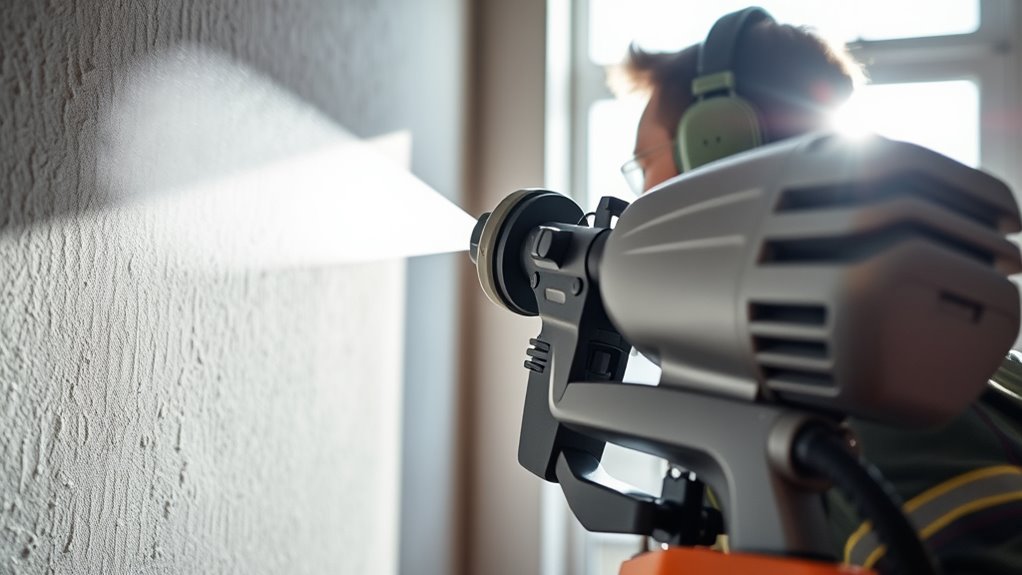
Choosing a quieter paint sprayer can substantially improve your work environment, especially if you frequently work in noise-sensitive areas or want to reduce fatigue. To achieve this, look for models designed with noise reduction techniques, which often feature sound-dampening components. Additionally, proper paint sprayer maintenance ensures excellent operation and minimizes unnecessary noise caused by worn parts or blockages. When selecting a quieter sprayer, consider these tips:
- Opt for electric or airless sprayers with noise-reduction features
- Regularly perform paint sprayer maintenance to reduce excess noise
- Use accessories like noise shields or mufflers to dampen sound further
Focusing on these aspects helps you work more comfortably while maintaining effective performance. Quieter options ultimately lead to a more pleasant and safer project environment.
Frequently Asked Questions
How Do Different Paint Sprayer Types Vary in Noise Production?
Different paint sprayer types vary in noise production based on their noise frequency and sound insulation. Airless sprayers tend to be louder, producing high-frequency noise that can be quite disruptive, while HVLP sprayers generate lower noise levels thanks to better sound insulation. You’ll notice that turbine sprayers are quieter overall due to their design. To minimize noise, consider models with enhanced sound insulation features, especially if you work in noise-sensitive environments.
Are Cordless Paint Sprayers Typically Quieter Than Electric Models?
Think of cordless paint sprayers as the stealthy ninjas of the painting world. Their cordless advantages make them generally quieter than electric models, allowing you to work with less noise and more freedom. Electric noise can be a headache, but cordless sprayers often hum softly, like a whisper, giving you a more peaceful experience. So, if quietness matters, go cordless — it’s like painting with a gentle breeze instead of a thunderstorm.
Can Paint Sprayers Be Modified to Reduce Noise Levels?
You can modify paint sprayers to reduce noise by adding soundproof enclosures and muffler attachments. Soundproof enclosures help contain the noise, making your work environment quieter. Muffler attachments specifically target the motor noise, dampening loud sounds during operation. These modifications are effective for lowering noise levels, allowing you to work more comfortably and minimize disturbance to others nearby. Just verify the modifications don’t interfere with the sprayer’s performance.
How Does the Size of the Paint Sprayer Impact Its Noise Output?
Think of a small garden hose versus a fire hydrant—you’ll notice the difference in sound. Similarly, a larger paint sprayer impacts noise levels because it handles greater paint flow and produces a bigger spray pattern, which often results in louder operation. Smaller sprayers tend to be quieter, ideal for detail work. So, the size directly influences how much noise you hear, based on how much paint and air are being pushed through.
What Are the Long-Term Health Effects of Exposure to Loud Paint Sprayer Noise?
Exposure to loud paint sprayer noise over time can lead to occupational hearing loss. Chronic noise exposure damages your hearing cells, making you less able to hear high-frequency sounds. Long-term, this can cause communication difficulties and stress. To protect your health, wear ear protection consistently and limit your time around loud equipment. Taking these steps helps prevent irreversible damage from ongoing noise exposure.
Conclusion
Understanding paint sprayer noise helps you protect your hearing and choose the right equipment. While some models are surprisingly loud, shielding your ears and working in quieter environments can make a big difference. Think of it like tuning a radio — adjusting your approach guarantees you stay safe without sacrificing efficiency. So, don’t ignore the noise; instead, take steps to minimize it and enjoy your projects safely and comfortably.
A seasoned painter with over 15 years in the industry, Mike transitioned from hands-on painting projects to the digital world of paint sprayers. His extensive experience gives him a unique perspective on what users truly need when it comes to painting tools. As the Editor in Chief of Paint Sprayer Zone, Mike ensures that every piece of content not only provides value but also reflects the realities of painting — the challenges, the joys, and the intricate details.



